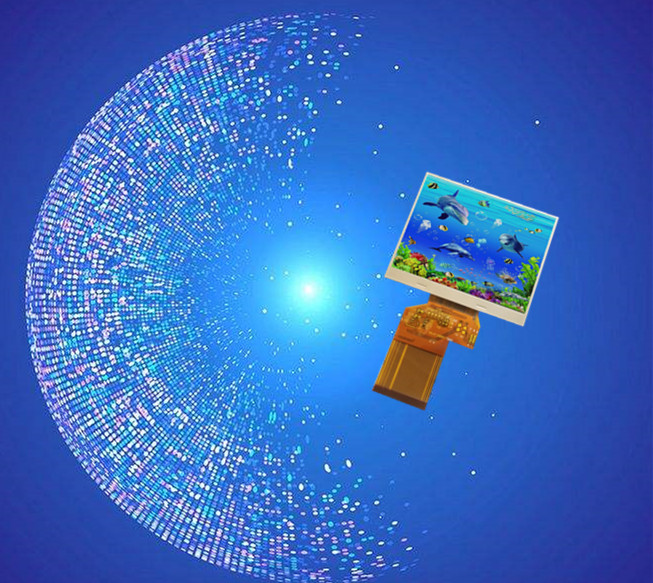Categories
- Technology (6)
- Application (6)
- News (5)
» Technology » Principle Classification And Application Of OLED Technology

OLED or Organic light-emitting Diode is the Emitting Light Emitting Diode, Also known as aka Organic Electroluminesence Display (OELD). Because of their lightness and power saving, OLED screens have many advantages over LCD screens.
OLED principle:
OLED refers to the phenomenon that organic semiconductor materials and luminescent materials, it can driven by electric field, it also can be emit light through carrier injection and composite. the principle is to use ITO transparent electrode and metal electrode as the anode and cathode of the device,that respectively. Under a certain voltage drive, electrons and holes are injected into the electron and hole transport layer from the cathode and anode respectively, the electrons and holes migrate to the luminescent layer through the electron and hole transport layer respectively, and meet in the luminescent layer to form excitons and excite the luminescent molecules, and the latter emits visible light through radiation relaxation. The irradiated light can be observed from the ITO side, and the metal electrode film also ACTS as a reflector. Displays based on this principle are called organic light emitting displays, or OLED displays.
OLED technical feature:
OLED Compared with LCD has active luminescence and no Angle problem. Light weight, small thickness; High brightness, high luminous efficiency; Rich luminous materials, easy to achieve color display; Fast response speed and high dynamic picture quality; Wide application temperature range; Soft display can be realized; Simple process and low cost; Strong earthquake resistance and a series of advantages, so it is called the future experts ideal display.
OLED product category:
Here are a few oleds – passive matrix OLED, active matrix OLED, transparent OLED, top emitting OLED, foldable OLED, white light OLED, and more Each OLED has its own unique use. In the following, we will discuss each OLED.
The first is passive matrix and active matrix OLED.
OLED passive matrix (PMOLED)
PMOLED has cathode strip, organic layer and anode strip. The anode strip is perpendicular to the cathode strip. The intersection of the cathode and the anode forms a pixel, which is where the light is emitted. External circuits apply current to the selected cathode and anode bands to determine which pixels emit light and which do not. In addition, the brightness of each pixel is proportional to the magnitude of the applied current.
PMOLED is easy to make but USES more power than other types of OLED, mainly because it requires an external circuit. PMOLED is most efficient at displaying text and ICONS, and is suitable for making small screens (2-3 inches diagonally), such as those you see on mobile phones, palm computers, and MP3 players. Even with an external circuit, passive matrix oleds use less power than the LCDS currently used in these devices.
OLED Active Matrix(AMOLED)
AMOLED has a complete cathode layer, organic molecular layer and anode layer, but the anode layer is covered by a thin film transistor (TFT) array to form a matrix. The TFT array itself is a circuit that determines which pixels emit light, which in turn determines the composition of the image.
AMOLED USES less power than PMOLED because TFT arrays require less power than external circuits, making AMOLED suitable for large displays. AMOLED also has a higher refresh rate and is suitable for displaying video. The best USES for AMOLED are computer monitors, large-screen TVS, and electronic signs or kanbans.
transparency OLED :
Transparent OLED has only transparent components (base, anode, cathode) and up to 85% of the transparency of base when not luminous. When a transparent OLED display is powered on, light can pass in both directions. Transparent OLED displays can be either passive or active. The technology could be used to make head-up displays that are often used in aircraft.
Top emission OLED
The top emitting OLED has an opaque or reflective base. They are best suited for active matrix design. Manufacturers can make smart CARDS using light-emitting OLED displays at the top.
Can be folded OLED
The flexible OLED base is made of flexible foil or plastic. Collapsible oleds are lightweight and extremely durable. hey can be used in devices, such as mobile phones and handheld computers, effectively reducing the rate of equipment breakage, which is a major incentive for returns and repairs. In the future, foldable oleds could be sewn into fibers to create a “smart” garment. Future field survival suits, for example, could stitch together computer chips, mobile phones, GPS receivers and OLED displays into clothing.
White Light OLED : The brightness, equalization and energy efficiency of the white light produced by the OLED are higher than that of the fluorescent light. White light OLED also has the true color characteristics of incandescent lighting. We can make large areas of OLED into thin sheets, so OLED can replace the fluorescent lights currently used in homes and buildings. In the future, the use of oleds is expected to reduce the energy consumption required for lighting.
Product outlook:
1.OLED screen MP3 MP4
OLED display technology has been widely used in MP3, MP4, in the panel design, there is a colorful backlight design, on the basis of further development, some areas have begun to use color OLED panel.
2.OLED Mobile phone screen:
OLED screens for mobile phones are already being tried, but not in the widespread stage. Samsung’s panel company have USES active OLED(AMOLED) screens in mobile phones already. A number of mobile phones with AMOLED displays have been sold on the market with high display accuracy, such as the AMOLED screen used in lenovo lephone.
In the future, if the OLED screen can be made soft and the internal chip can be made soft, it is likely that the mobile phone can be curled up at a small Angle and will be even thinner
3.OLED Table computer:
OLED can be used in tablets to create ultra-thin, flexible products, or even full-body transparent tablets. It has built-in window-glass navigation, true 3d interior design software, planning interior design on transparent screen, and using split bar can split the screen into two independent screens to share with others. Transparent technology and augmented reality applications will make the traditional tablet even more versatile.
4.OLED TV
SONY introduced an 11-inch OLED TV in Japan in December 2007. Some manufacturers including Toshiba, panasonic and a number of domestic brands, are also vying to enter the market, especially as OLED TVS are likely to be the dominant force in the next generation of TVS at a time, when LCD(including LED) LCD TVS and PDP plasma TVS are slowing in volume.
OLED TVS feature ultra-thin, wide-viewing angles and even “soft” TVS with screens that can be folded and bent. It can be hung like a piece of paper on the wall or carried in a pocket. Apple is also rumored to be eyeing the possibility of a 55-inch LG OLED display in the Apple TV.
Note: information from FPDisplay original or media partners
